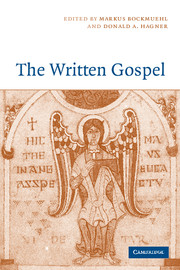Book contents
- Frontmatter
- Contents
- List of contributors
- List of abbreviations
- Introduction
- PART I BEFORE WRITING
- PART II WRITING THE FOUR GOSPELS
- PART III AFTER WRITING
- 11 The Four among Jews
- 12 The Four among pagans
- 13 Forty other gospels
- 14 The One, the Four and the many
- 15 The making of gospel commentaries
- Appendix: Graham Stanton's publications
- Bibliography
- Index of ancient sources
- Index of authors
14 - The One, the Four and the many
Published online by Cambridge University Press: 07 December 2009
- Frontmatter
- Contents
- List of contributors
- List of abbreviations
- Introduction
- PART I BEFORE WRITING
- PART II WRITING THE FOUR GOSPELS
- PART III AFTER WRITING
- 11 The Four among Jews
- 12 The Four among pagans
- 13 Forty other gospels
- 14 The One, the Four and the many
- 15 The making of gospel commentaries
- Appendix: Graham Stanton's publications
- Bibliography
- Index of ancient sources
- Index of authors
Summary
The existence and use of multiple sources of tradition about Jesus in the first and second centuries ce has been clearly demonstrated in the earlier chapters of this volume. Few scholars would be so bold as to claim that an accurate inventory of such sources can actually be compiled today, but this is because many such sources failed to be preserved. Furthermore, a continuing oral tradition is likely to have existed alongside written ‘gospels’ and other documents incorporating Jesus tradition. Even if some such sources circulated widely amongst Christians in the ancient Mediterranean, it is probable that particular groups or networks of Christians adopted favourite sources of tradition. Insofar as this was the case, the sources of Jesus tradition may not have been merely complementary to one another, but may actually have been in competition with one another.
Yet by the latter half of the second century, Irenaeus argued forcefully for a fourfold gospel, consisting of the four gospels widely recognized as ‘canonical’ today. How did the choice of these four (the Gospels according to Matthew, Mark, Luke and John) achieve clear support at such an early stage? We shall see that there were many reasons for leaders in the early church to be concerned about the Jesus tradition being used for purposes that they considered theologically suspect. These concerns resulted in efforts to exercise some control over groups or networks choosing their own ‘favourites’ and over the multiplication of new authoritative sources of Jesus tradition.
- Type
- Chapter
- Information
- The Written Gospel , pp. 254 - 273Publisher: Cambridge University PressPrint publication year: 2005
- 1
- Cited by



